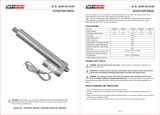
Servomech S.p.A. 02.50-63-80.E - Rev. 03 Date (M/Y) 12/19 7
4 USE RESTRICTION
The information contained in this chapter provides important prescriptions for operating safely during all
phases of the product's life.
Not knowing or not complying with these provisions can generate dangerous situations that could cause
damage to equipment and risks for the safety of persons.
4.1 Intended use
Actuators are used to perform very different functions within machines. It is the responsibility of the machine
builder to design the application in compliance with the laws in force in the specific sector and in the field of
safety, in compliance with the requirements provided in the product catalog and in this manual.
ACTUATORS ARE ELECTRIC AXIS, WHATEVER DRIVER OR CONTROL WILL BE USED: THE SELECTION OF
THE PRODUCT AS STROKE, SPEED, TYPE OF LIMIT SWITCHES, MOTOR AND BRAKE, MUST BE DONE
ACCORDING TO THE BEHAVIOR EXPECTED, IN FUNCTION OF THE TYPE OF CONTROL CHOOSEN AND
THE STATIC AND DYNAMIC BEHAVIOR OF THE SYSTEM IN WHICH THE ACTUATOR IS PLACED!
The actuators have been designed and built to operate mobile parts of various types, shapes and
construction, in the ways and within the limits set out in the descriptions and tables of the technical data in
the catalog and in this user manual.
The actuators are designed to work with a purely axial applied load.
They must be subjected to the loading and speed conditions specified in the catalog.
Modification of parts of the actuator or replacement of components with different and non-original parts is
not permitted. The replacement of components with original spare parts is carried out only by Servomech
S.p.A.
Any different use is to be considered improper and therefore potentially dangerous for the safety of the
operators, as well as such as to void the contractual guarantee.
In the event of particular processing requirements, we recommend consulting our sales department.
Every modification must be authorized by Servomech S.p.A. with written documents.
ANY OTHER USE OUTSIDE THAT THAT JUST DESCRIBED IS NOT PERMITTED BY SERVOMECH S.p.A.
4.1.1 Use restrictions
Actuators can not be used for unforeseen applications.
Any utilization of this device beyond its intended purpose may lead to potentially hazardous situations.
Therefore:
• Strictly adhere to all safety precautions and instructions in this operating manual.
• Do not allow this device to be subjected to weather conditions, strong UV rays, corrosive or explosive
air media as well as other aggressive media (*).
• Do not modify, retool or change the structural design or individual components of the actuator.
• Never use the device outside of the technical application and operational limits.
(*) – THE USE OF THE ACTUATOR IN ABOVE CONDITIONS MUST BE PREVIOUSLY DECLARED AND AGREED
WITH SERVOMECH, SINCE A SPECIAL EQUIPMENT OF THE PRODUCT MUST BE PROVIDED.
























